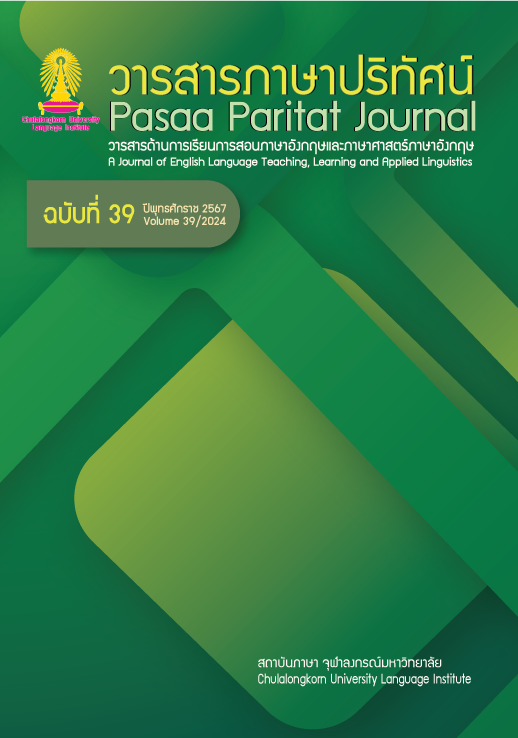A Linguistic Landscape Analysis of Sukhothai Historical Park
DOI:
https://doi.org/10.58837/CHULA.PPJ.39.6Keywords:
Linguistic Landscape, Public Signage, Language Usage, Sukhothai Historical Park, English as an International LanguageAbstract
The objectives of this study were to investigate the linguistic landscape of Sukhothai Historical Park in terms of the types of public signage and language choices and to examine the attitudes of governmental officials, tour guides, and tourists towards the role of English in the chosen research site. A total of 288 pictures were taken to outline the different types of linguistic landscape items. The analysis was conducted, and it was revealed that the signs encompassed various categories, including name signs (29.51%), traffic signs (23.96%), information signs (15.97%), moral signs (15.28%), regulation signs (10.07%), and map signs (5.21%). The language choices were thoroughly examined. The findings indicated that all of the signs in the targeted area featured "Only Thai script signs (9.37%)," "Only English script signs (5.56%)," and the most frequently encountered type, “Bilingual Signs with Script in Thai and English (Thai with equivalent translation in English) (85.07%)." The existence of English in the signs signifies a strategy to attract international visitors as it allows them to comprehend the intended message with ease. In addition, semi-structured interviews were conducted with 15 local government employees, tour guides, and foreign tourists. The findings indicate that English is practical in providing guidance, meeting tourism needs, and supporting advertising campaigns. It facilitated communication, comforted foreign travellers, and symbolized an international and modern perspective.
References
Akindele, D. O. (2011). Linguistic landscapes as public communication: A study of public signage in Gaborone Botswana. International Journal of Linguistics, 3(1), 1–11. https://doi.org/10.5296/ijl.v3i1.1157
Backhaus, P. (2006). Multilingualism in Tokyo: A look into the linguistic landscape. International Journal of Multilingualism, 3(1), 52–66. https://doi.org/10.1080/14790710608668385
Ben-Rafael, E., Shohamy, E., Amara, M. H., & Trumper-Hecht, N. (2006). Linguistic landscape as symbolic construction of the public space: The case of Israel. International Journal of Multilingualism, 3(1), 7–30. https://doi.org/10.1080/14790710608668383
Blommaert, J. (2013). Ethnography, superdiversity and linguistic landscapes: Chronicles of complexity. Multilingual Matters. https://doi.org/10.21832/9781783090419
Gorter, D. (2006). Linguistic landscape: A new approach to multilingualism. Multilingual Matters.
Gorter, D. (2018). Methods and techniques for linguistic landscape research: About definitions, core issues and technological innovations. In M. Pütz & N.-F. Mundt (Eds.), Expanding the linguistic landscape: Linguistic diversity, multimodality and the use of space as a semiotic resource (pp. 38–57). Multilingual Matters. https://doi.org/10.21832/9781788922166
Gorter, D., & Cenoz, J. (2007). Knowledge about Language and Linguistic Landscape. In N. H. Hornberger (Ed.), Encyclopedia of Language and Education (2nd rev. ed.) (pp. 1–13). Springer Sciences. https://doi.org/10.1007/978-0-387-30424-3_160
Guilat, Y., & Espinosa-Ramírez, A. B. (2016). The Historical Memory Law and its role in redesigning semiotic cityscapes in Spain: A case study from Granada. Linguistic Landscape: An International Journal, 2(3), 247–274. https://doi.org/10.1075/ll.2.3
Hicks, D. (2002, April). Scotlands linguistic landscape: the lack of policy and planning with Scotland´s place-names and signage. World Congress on Language Policies, Barcelona.
Hornsby, M. (2008). The incongruence of the Breton linguistic landscape for young speakers of Breton. Journal of Multilingual and Multicultural Development 29(2), 127–138. https://doi.org/10.2167/jmmd538.0
Huebner, T. (2006). Bangkok’s linguistic landscapes: Environmental print, codemixing, and language change. In D. Gorter (Ed.), Linguistic landscape: A new approach to multilingualism. Multilingual Matters. https://doi.org/10.1080/14790710608668384
Hult, F. M. (2013). Drive-thru linguistic landscaping: Constructing a linguistically dominant place in a bilingual space. International Journal of Bilingualism, 18(5), 507–523. https://doi.org/10.1177/1367006913484206
Kasanga, L. A. (2012). English in the Democratic Republic of the Congo. World Englishes, 31(1), 48–69. https://doi.org/10.1111/j.1467-971X.2011.01732.x
Landry, R., & Bourhis, R. Y. (1997). Linguistic landscape and ethnolinguistic vitality: An empirical study. Journal of Language and Social Psychology, 16(1), 23–49. https://doi.org/10.1177/0261927X970161002
Litvinskaya, A. A. (2010). Linguistic landscape of ‘Little Russia by the Sea’, A multilingual community in a Brooklyn Area of New York City. Indiana University of Pennsylvania.
Potisuwan, S., Methitham, P., & Rungrueng, A. (2020, March 27). Exploring the role of english in shaping the Linguistic landscape: A case study of the metropolitan area of Chiang Mai, Thailand. Proceedings of 11th International Academic Conference "Global Goals, Local Actions: Looking Back and Moving Forward, Bangkok, Thailand.
Reh, M. (2004). Multilingual writing: A reader-oriented typology – with examples from Lira Municipality (Uganda). International Journal of the Sociology of Language, 30(170), 1–41. https://doi.org/10.1515/ijsl.2004.2004.170.1
Ross, N. J. (1997). Signs of international english. English Today, 13(2), 29–33. https://doi.org/10.1017/S0266078400009597
Shohamy, E. (2006). Language policy: Hidden agendas and new approaches. Routledge. https://doi.org/10.4324/9780203387962
Shohamy, E., & Gorter, D. (2009). Introduction. In E. Shohamy & D. Gorter (Eds.), Linguistic landscape: Expanding the scenery (pp. 1–10). Routledge.
Shohamy, E., & Waksman, S. (2009). Linguistic landscape as an ecological arena: Modalities, meanings, negotiations, education. In E. S. a. D. Gorter (Ed.), Linguistic landscape: expanding the scenery (pp. 313–331). Routledge.
Siricharoen, A. (2016). Multilingualism in the linguistic landscape of the Faculty of Arts, Chulalongkorn University, Thailand [Special Issue]. MANUSYA: Journal of Humanities, 19(3), 12–25. https://doi.org/10.1163/26659077-01903002
Sutthinaraphan, K. (2016). A linguistic landscape study of advertising signage on skytrain [Special Issue]. MANUSYA: Journal of Humanities, 19(3), 53–71. https://doi.org/10.1163/26659077-01903005
Tan, S. X. W., & Tan, Y. Y. (2015). Examining the functions and identities associated with English and Korean in South Korea: a linguistic landscape study. Asian Englishes, 17(1), 59–79. https://doi.org/10.1080/13488678.2015.999406
Thongtong, T. (2016). A linguistic landscape study of signage on Nimmanhemin Road, a Lanna Chiang Mai chill-out street. MANUSYA: Journal of Humanities, 19(3), 72–87. https://doi.org/10.1163/26659077-01903006
Xia, N., & Li, L. (2016). Studying languages in the linguistic landscape of Lijiang Old Town. International Journal of English Linguistics 6(2), 105–117. https://doi.org/10.5539/ijel.v6n2p105
Yanhong, M., & Rungruang, A. (2013). Chiang Mai’s linguistic landscapes in the tourist attraction areas: A study on the English language use on signs. The Golden Teak: Humanity and Social Science Journal, 19(2), 59–70.
Downloads
Published
How to Cite
Issue
Section
License
Copyright (c) 2024 Pasaa Paritat Journal

This work is licensed under a Creative Commons Attribution-NonCommercial-NoDerivatives 4.0 International License.



